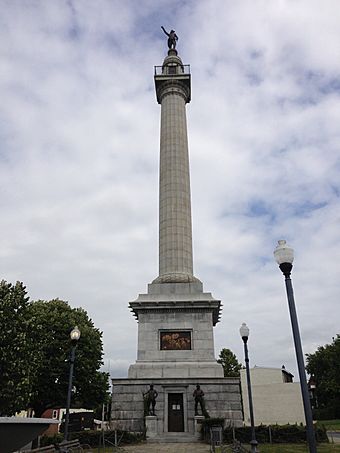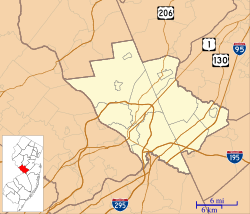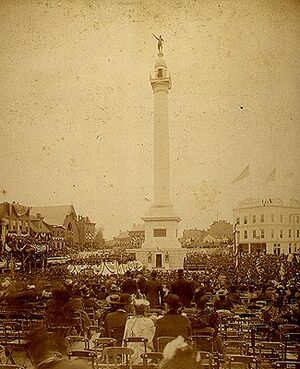Trenton Battle Monument facts for kids
|
Trenton Battle Monument
|
|
 |
|
| Location | Trenton, New Jersey |
|---|---|
| Built | 1891–93 |
| Architect | John H. Duncan |
| Architectural style | Beaux Arts Sculptors: William Rudolf O'Donovan Thomas Eakins Charles Henry Niehaus |
| NRHP reference No. | 77000881 |
Quick facts for kids Significant dates |
|
| Added to NRHP | May 6, 1977 |
The Trenton Battle Monument is a very tall monument in Trenton, New Jersey. It stands in the part of the city called "Battle Monument." This important structure remembers the Battle of Trenton, which took place on December 26, 1776. This battle was a major victory for the American army during the American Revolutionary War.
Contents
What the Monument Looks Like
The monument was designed by John H. Duncan. He also designed Grant's Tomb in New York City. The Trenton monument is an early example of a style called Beaux-Arts architecture in America.
The design was inspired by "The Monument" in London, England. That monument was built in 1671 to remember a big fire. The Trenton monument is the same height as the London one.
The Tall Column and Top
The monument is a hollow column made of granite stone. It has grooves running up and down, like a Roman-style pillar. The column stands on a base, also made of granite, but a bit darker. This makes the base look very strong.
At the very top of the column is a small, round viewing area. You can reach it by an elevator. From here, thousands of visitors have enjoyed great views of Trenton and the battleground. Around the top of the column, there are thirteen electric lights. These lights represent the original Thirteen Colonies of America. They shine brightly at night.
Statue of George Washington
Above the viewing area, there is a huge bronze statue of General George Washington. This statue was created by William Rudolf O'Donovan. Washington is shown as he looked at the start of the battle. With his right hand, he points, directing the American cannons down King Street (now Warren Street). The statue itself is 13 feet (4.0 m) tall. The entire monument, including the statue, reaches 150 feet (46 m) above the street.
Bronze Art Panels
On the base of the monument, there are three large bronze art panels.
- Two panels were made by Thomas Eakins. One shows "The Continental Army Crossing the Delaware River." The other shows "The Opening of the Battle," with Alexander Hamilton's cannons ready to fire.
- The third panel, "The Surrender of the Hessians," was made by Charles Henry Niehaus.
- On the north side of the base, there is also a bronze plaque from the Society of the Cincinnati of New Jersey.
Soldier Statues
At the entrance of the monument, two bronze statues of American soldiers stand guard. These were also made by O'Donovan.
- One statue is of Private John Russell. He was part of Colonel John Glover's "Marblehead Regiment." These were skilled sailors from Marblehead, Massachusetts. They famously helped Washington's army cross the icy Delaware River on Christmas night, 1776.
- The other statue is of Private Blair McClenachan. He was from the "Philadelphia Light Horse Troop," another unit that fought in the battle.
History of the Monument
The monument is located in a part of Trenton called "Five Points." This is where several streets meet: Warren (King) Street, North Broad (Queen) Street, Brunswick, Pennington, and Princeton Avenues. During the battle, American cannons were placed here. From this high spot, they could control the streets of Trenton. This stopped the Hessian (German) troops from fighting back effectively.
Building the Monument
People started wanting a monument to the Battle of Trenton way back in 1843. About 40 years later, in 1886, the land for the monument was bought by the Trenton Monument Association.
To pay for it, the New Jersey government gave $15,000. The U.S. Congress gave $30,000. And citizens also donated $15,000. The park around the monument was officially created in 1893.
Key Dates in Construction
- The first stone was laid on Saturday, December 26, 1891. This was the 115th anniversary of the Battle of Trenton.
- The base and pedestal were built in the spring of 1892.
- The top stone was put in place on Saturday, August 31, 1893.
- The statue of General Washington was finally placed on top on September 5, 1893.
The completed monument was officially opened with a big ceremony on October 19, 1893. This date was the 112th anniversary of the surrender of General Lord Cornwallis at the Battle of Yorktown in Virginia. Eight governors from the original thirteen states attended the ceremony.
Even though the area around the monument has changed over time, the statue of Washington still looks down on the city. Trenton has grown a lot since it was a small village in 1776. The monument was added to the National Register of Historic Places in 1977, recognizing its importance.
Unfortunately, the elevator inside the monument is not working, so visitors cannot go up to the viewing area right now.
See also
 In Spanish: Monumento a la batalla de Trenton para niños
In Spanish: Monumento a la batalla de Trenton para niños





